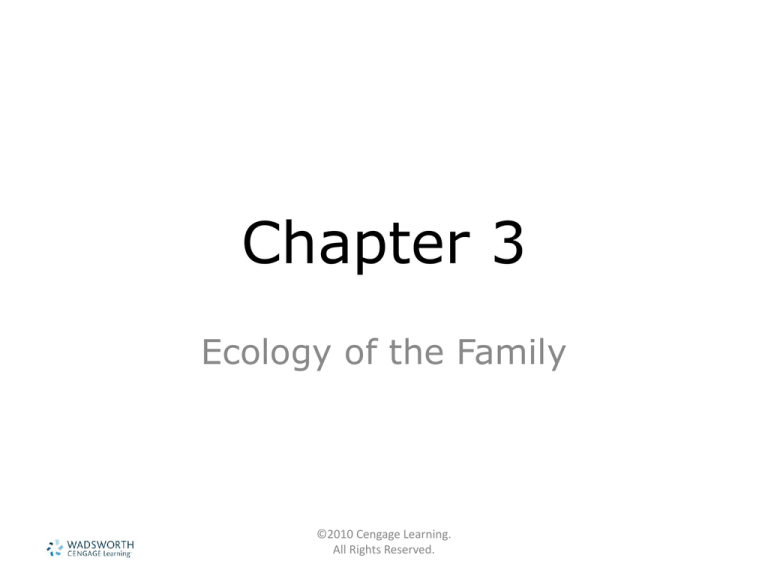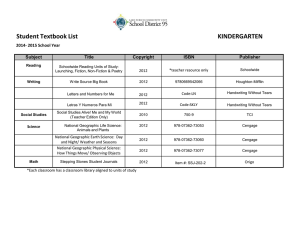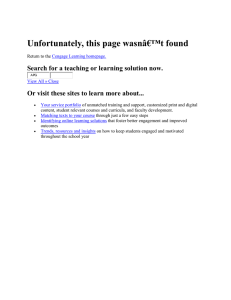
Chapter 3
Ecology of the Family
©2010 Cengage Learning.
All Rights Reserved.
In my very own self, I am part
of my family.
D.H. Lawrence
©2010 Cengage Learning.
All Rights Reserved.
Family Systems
©2010 Cengage Learning.
All Rights Reserved.
Family Structures
• Nuclear family
– A family consisting of a husband, a wife,
and their children
• Extended family
– Relatives of the nuclear family who are
economically and emotionally dependent
on each other
©2010 Cengage Learning.
All Rights Reserved.
Family Structures
• Family of orientation
– The family into which one is born
• Family of procreation
– The family that develops when one
marries and has children
©2010 Cengage Learning.
All Rights Reserved.
Family Structures
• Matriarchal family
– A family in which the mother has formal
authority and dominance
• Patriarchal family
– A family in which the father has formal
authority and dominance
• Egalitarian family
– A family in which both sides of the
extended family are regarded as equal
©2010 Cengage Learning.
All Rights Reserved.
Family Functions
•
•
•
•
•
Reproduction
Socialization/education
Assignment of social roles
Economic support
Nurturance/emotional support
©2010 Cengage Learning.
All Rights Reserved.
Family Transitions
©2010 Cengage Learning.
All Rights Reserved.
Structural
Divorced families
Single-parent and joint custody
Kin custody
Stepfamilies
Single-parent families
Lesbian, gay, bisexual, and
transgender families
• Adoptive families
•
•
•
•
•
•
©2010 Cengage Learning.
All Rights Reserved.
Divorce
• Effect on children depends on
– Age and gender
– Custody arrangements
– Emotional support
• Binuclear family
– A family pattern in which children are
part of two homes and two family
groups
©2010 Cengage Learning.
All Rights Reserved.
Custody
• Single-Parent Custody
– Single-parents can experience
economic, emotional, physical strain
• Joint Custody
• Kin Custody
– Children raised by relatives other than
parents, the most common being
grandparents raising grandchildren
©2010 Cengage Learning.
All Rights Reserved.
Changes Over Time
©2010 Cengage Learning.
All Rights Reserved.
Changes Over Time
•
•
•
•
•
•
•
Reproduction
Socialization/education
Assignment of social roles
Authority patterns
Economic support
Dual-earner families
Nurturance/emotional support
©2010 Cengage Learning.
All Rights Reserved.
Macrosystem
Influences
©2010 Cengage Learning.
All Rights Reserved.
Socioeconomic Status
• Ascribed status
– Social class, rank, or position
determined by family lineage, gender,
birth order, or skin color
• Achieved status
– Social class, rank, or position
determined by education, occupation,
income, and/or place of residence
©2010 Cengage Learning.
All Rights Reserved.
Socioeconomic Status
• Socioeconomic status
– Rank or position within a society, based
on social and economic factors
•
•
•
•
Upper class
Middle class
Lower class
Underclass
©2010 Cengage Learning.
All Rights Reserved.
Socioeconomic Effects
• Children’s socialization experiences
vary by socioeconomic class.
• Different socialization experiences
result in different outcomes.
©2010 Cengage Learning.
All Rights Reserved.
Cultural Orientation
•
•
•
•
Gemeinschaft
Gesellschaft
Collectivism
Individualism
©2010 Cengage Learning.
All Rights Reserved.
Religious Orientation
• Religion
– A unified system of beliefs and practices
relative to sacred things
• Religion provides an ideology that
enables individuals to comprehend
events.
©2010 Cengage Learning.
All Rights Reserved.
Chronosystem
Influences
©2010 Cengage Learning.
All Rights Reserved.
Chronosystem
Influences
• Sociopolitical Changes
– Immigration Policies
– Foreign Policies
– Domestic Policies
• Economic Changes
• Technological Changes
©2010 Cengage Learning.
All Rights Reserved.
Family Empowerment
©2010 Cengage Learning.
All Rights Reserved.
Family Empowerment
• Empowerment
– Enabling individuals to have control over
resources affecting them
©2010 Cengage Learning.
All Rights Reserved.





